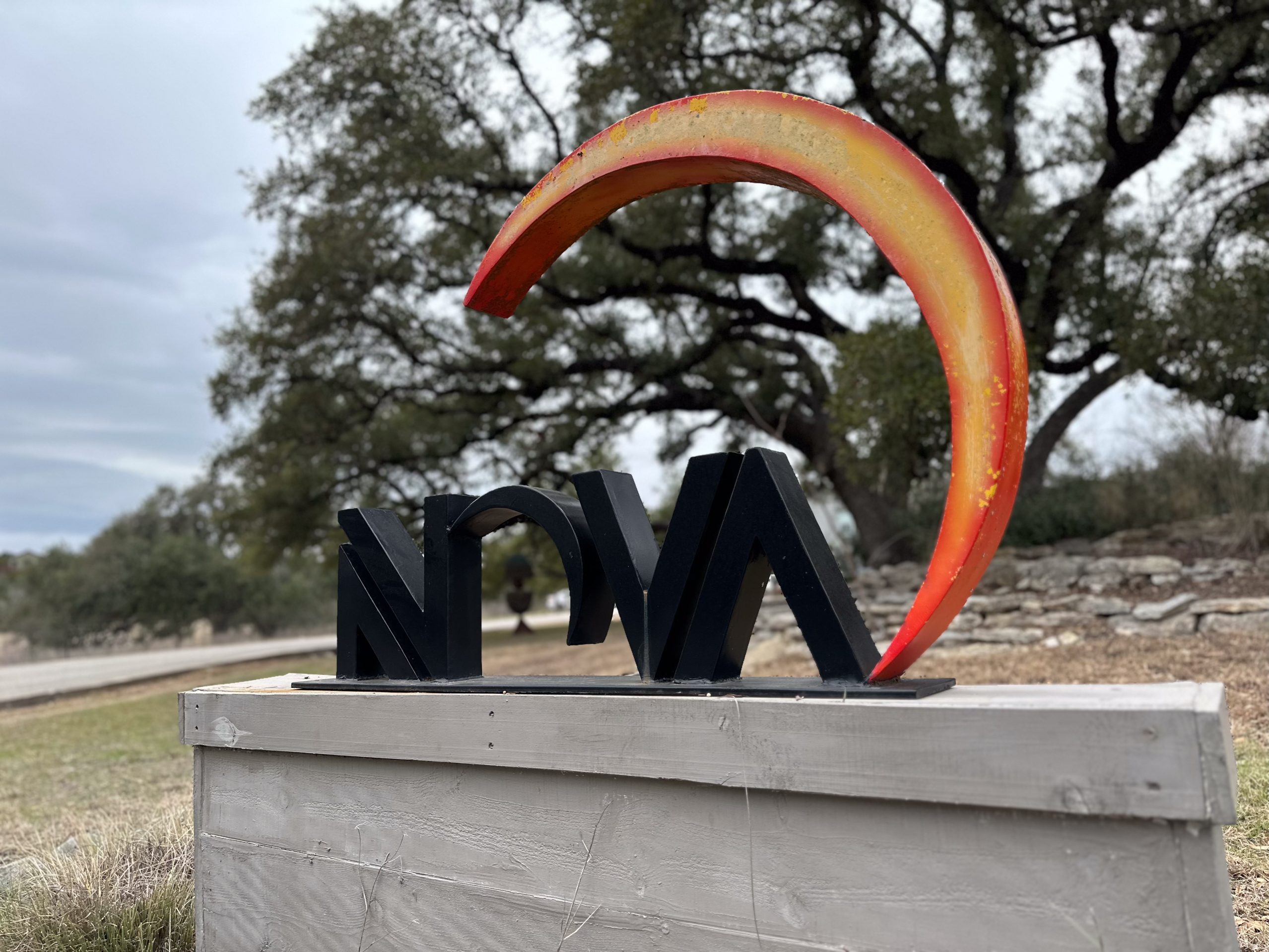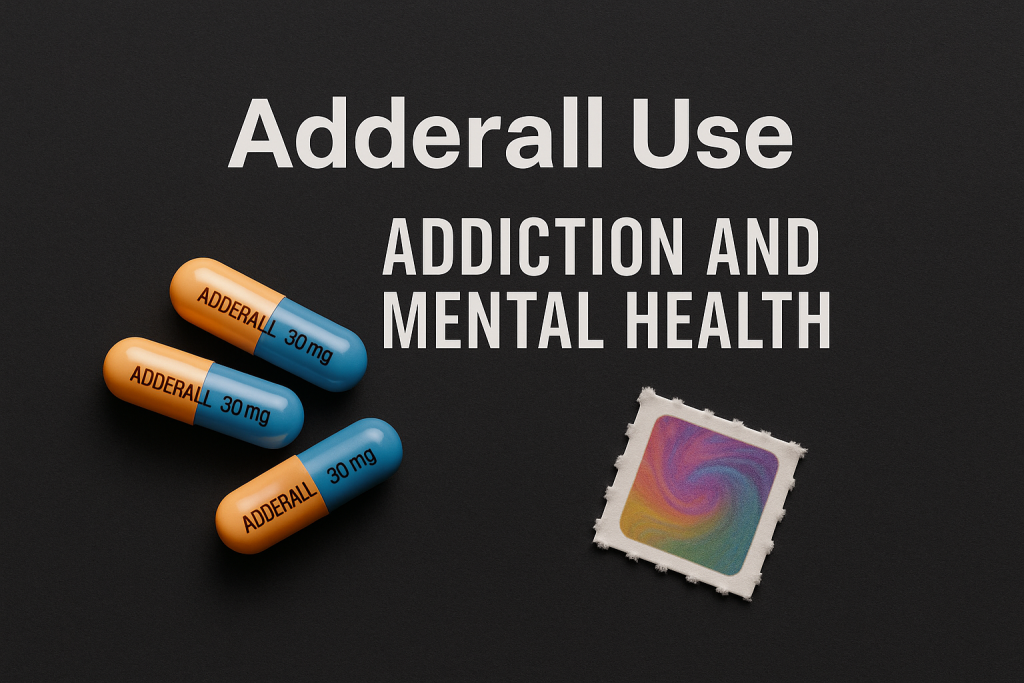Last Updated on September 21, 2025
Adderall Use, Addiction, and Mental Health: What to Know
At a Glance: Adderall Use, Addiction, and Mental Health
- Adderall is an amphetamine prescribed for ADHD and narcolepsy, but it carries risks for misuse and dependence.
When used correctly, Adderall can improve focus, reduce impulsivity, and support daily functioning. - Misuse and overuse may lead to anxiety, mood swings, sleep disruption, and higher risk of addiction.
- Mental health concerns such as depression, anxiety, or psychosis often co-occur with stimulant misuse.
- Integrated treatment is essential to address both substance use and underlying mental health conditions.
Table of Contents
Adderall is widely prescribed for ADHD and sometimes narcolepsy, yet discussion around adderall use increasingly touches on mental health, misuse, and polysubstance risks. This guide explains how Adderall works, why adderall an amphetamine matters clinically, the mental‑health implications of long‑term use or misuse, and what we know (and don’t) about lsd and adderall—with evidence‑based safety guidance and help resources










What Is Adderall?
Medical indications and class
Adderall is a prescription central nervous system stimulant indicated for attention‑deficit/hyperactivity disorder (ADHD) and, in certain cases, narcolepsy. Clinicians generally use the immediate‑release (Adderall) and extended‑release (Adderall XR, Mydayis) formulations as part of a broader treatment plan that can include behavioral therapy, skills training, or educational supports.
How Adderall works in the brain
Stimulants like Adderall primarily modulate dopamine and norepinephrine signaling—two neurochemicals central to attention, motivation, and arousal. Therapeutic dosing can improve focus and impulse control in people with ADHD, but the same pharmacology also explains why misuse can reinforce compulsive patterns of taking the drug.
Is Adderall an Amphetamine?
Yes. Adderall is a mixture of d‑amphetamine and l‑amphetamine salts (often called “mixed amphetamine salts”), in a 3:1 ratio of d‑ to l‑isomers. In other words, Adderall is an amphetamine—and the common search phrase “adderall an amphetamine” reflects this exact point. The amphetamine class raises alertness and activity by increasing synaptic dopamine and norepinephrine and blocking their reuptake; it also carries a known risk for misuse and dependence when not taken as prescribed.
Adderall Use and Mental Health
Benefits with appropriate, supervised use
For patients with ADHD, appropriate adderall use (right diagnosis, dosing, and monitoring) can reduce core symptoms, improve task completion, and support functioning at school, work, and home. These benefits are why stimulants remain frontline ADHD therapies in clinical guidelines.
Mental‑health risks, especially when misused
Misuse (taking higher doses or using without a prescription) can trigger anxiety, agitation, sleep disruption, and mood swings; it can also worsen underlying psychiatric vulnerabilities. Over time, misuse may alter reward pathways in ways that sustain compulsive use and increase addiction risk.
Co‑occurring disorders are common
Substance use disorders frequently co‑occur with mental health conditions such as anxiety, depression, PTSD, or psychotic‑spectrum disorders; when both are present, each can complicate the other’s course and treatment. That reality underscores the need for integrated care, not siloed approaches.
Freedom Starts Here. Take Back Your Life Today.
Same-Day Admissions in Austin Available.
Short‑ and Long‑Term Side Effects & Warnings
Common and serious effects
Typical adverse effects include decreased appetite, insomnia, dry mouth, and headache. Serious reactions—although less common—can include elevated blood pressure/heart rate, chest pain, new or worsening psychiatric symptoms (e.g., agitation, paranoia, hallucinations), and, rarely, cardiac events, particularly in individuals with pre‑existing heart disease. Children may experience slowed growth, so height/weight monitoring is standard.
Black‑box style cautions and misuse potential
Amphetamines carry a high potential for misuse. The FDA label highlights the risk of dependence, cardiovascular events, and the need for careful patient selection and monitoring. Clinicians are advised to reassess long‑term utility periodically and to use the lowest effective dose.
Special populations and life stages
- Cardiovascular disease: Stimulants can raise blood pressure and pulse; screening and ongoing monitoring are prudent in patients with known cardiac risk.
- Pregnancy & lactation: Guidance is cautious due to limited data and potential risks; risk–benefit discussions are essential. Amphetamines are excreted into human milk.
- Pediatrics: Growth and sleep should be monitored; prescribers often incorporate drug holidays and periodic re‑evaluation.
Interactions You Should Know About
Medication and supplement interactions
Adderall’s exposure may increase with CYP2D6 inhibitors (e.g., certain antidepressants), potentially raising the risk for serotonin syndrome when serotonergic drugs are involved. Alkalinizing agents (e.g., sodium bicarbonate, some diuretics) can increase amphetamine blood levels; acidifying agents can decrease them. Always review all prescriptions and over‑the‑counter products (including antacids and supplements) with a clinician.
LSD and Adderall: why this mix is risky
The phrase “lsd and adderall” often appears in searches about mixing substances. Two key issues explain the risk:
- Overlapping autonomic stimulation. In controlled comparisons, d‑amphetamine and LSD both increased heart rate, blood pressure, body temperature, and pupil size—differences exist, but the net effect is sympathetic activation. Combining them could compound strain on the cardiovascular system and heighten anxiety or panic.
- Uncertain, understudied interactions. Systematic reviews note limited human data on pharmacodynamic and pharmacokinetic interactions between classic psychedelics (like LSD) and other drugs. The lack of evidence does not mean safety; it means unpredictable responses, including intensified psychological effects or dangerous physiological reactions, are possible.
Because LSD also acts strongly at 5‑HT2A receptors and amphetamines raise catecholamine signaling, co‑use may amplify distressing experiences (e.g., agitation, paranoia) and physiologic stress. If someone has combined them and develops chest pain, severe anxiety, confusion, hyperthermia, or hallucinations, seek emergency care.
Misuse, Dependence, and Addiction
How misuse develops
Taking higher‑than‑prescribed doses, dosing more often than directed, or using Adderall without a prescription can reinforce use via dopamine‑mediated reward—especially under stressors like exams, deadlines, or sleep loss. Over time, this pattern may meet criteria for a stimulant use disorder.
Warning signs to watch for
- Escalating dose or frequency, especially without clinician input
- Using to study, party, or “cope” rather than to treat ADHD
- Significant sleep disruption, appetite loss, or mood instability
- Social withdrawal, secrecy around pills, or doctor/online shopping for extras
(If these resonate, a substance use assessment is appropriate.)
Withdrawal and stopping safely
Abruptly stopping high‑dose or prolonged adderall use can trigger fatigue, low mood, sleep changes, and cravings. Tapering under medical detox supervision, with support for sleep, mood, and daily structure, is generally safer than going “cold turkey.”
Freedom Starts Here. Take Back Your Life Today.
Same-Day Admissions in Austin Available.
Treatment Options (and What Good Care Looks Like)
Comprehensive, integrated care
Because substance use often overlaps with anxiety, depression, trauma, or other conditions, integrated treatment—where mental health and substance use are addressed together—improves outcomes. Care plans typically combine behavioral therapies (e.g., CBT, contingency management), psychoeducation, skills training, and recovery supports.
Medication strategy
For people with ADHD and a stimulant use disorder, clinicians may:
- Re‑evaluate the ADHD diagnosis and functional goals
- Consider non‑stimulant options (atomoxetine, guanfacine, clonidine, bupropion) where appropriate
- If stimulants remain indicated, use careful monitoring, long‑acting formulations, lower doses, pill counts, and prescription monitoring‑program checks
(Medication choices must be individualized; discuss risks/benefits with a qualified prescriber.)
Recovery supports
Peer groups, digital CBT tools, and family education can stabilize routines and reduce relapse risk. When social determinants (housing, food, sleep, workload) are addressed, treatment retention improves.
Practical Safety Tips (Harm Reduction)
- Use only as prescribed and avoid sharing—diversion is illegal and unsafe.
- Screen your meds (including OTCs and supplements) for interactions; ask specifically about antidepressants, antacids, and anything affecting stomach or urine pH.
- Prioritize sleep and nutrition. Sleep debt and caloric deficits magnify anxiety and crash symptoms.
- Avoid mixing, especially with other stimulants, alcohol, and LSD or other psychedelics, given unpredictable cardiovascular and psychological effects.
- Have a plan if you feel out of control: identify a trusted person, urgent‑care options, and crisis resources ahead of time.
Is Adderall the same as methamphetamine?
No. Both are Schedule II stimulants, but they are different molecules with different profiles, dosing, and approved uses. That said, both elevate catecholamine signaling and carry misuse potential—hence similar cardiac and psychiatric cautions.
Why do some people feel calmer on Adderall?
In ADHD, carefully dosed stimulants can “normalize” attention and reduce impulsivity via dopamine/norepinephrine effects—improving function rather than causing a “high.” Misuse changes the risk–benefit balance and may worsen anxiety or mood.
Is long‑term Adderall treatment safe?
Many patients use stimulants long‑term under supervision. Periodic re‑evaluation, the lowest effective dose, and monitoring (BP, pulse, growth in kids, sleep/mood) are best practices.
What should I do if I’ve been mixing lsd and adderall?
If stimulant use is straining your mental health, relationships, school, or work—or if you’re worried about mixing substances—talk with a clinician experienced in both ADHD and addiction care. If you need confidential help finding treatment, contact the SAMHSA National Helpline (1‑800‑662‑HELP).
Read more on Addiction and Mental Health
Get Help for Adderall Addiction in Austin, Texas
If you or someone you love is struggling with Adderall misuse and mental health concerns, Nova Recovery Center is here to help. Our Drug and Alcohol Rehab in Austin, TX provides evidence-based treatment tailored to each individual’s needs. With programs ranging from medical detox in Austin, TX to long-term inpatient care, intensive outpatient rehab Austin, Texas, and sober living in Austin Texas, we offer a complete continuum of support for lasting recovery.
Our team specializes in treating Adderall addiction alongside co-occurring mental health conditions such as anxiety, depression, or sleep disorders. By combining therapy, relapse prevention training, and holistic healing approaches, we give clients the tools to achieve sobriety and maintain balance in daily life.
Don’t wait to take the first step. Call Nova Recovery Center today to learn more about Adderall addiction treatment in Austin, Texas, and see availability now. Most insurances are accepted, and our admissions specialists are available to provide a confidential insurance and availability check.
Read more on Addiction and Mental Health
Adderall Use, Mental Health Risks, and FAQs About LSD and Adderall
Is Adderall actually an amphetamine?
Yes—Adderall is a specific blend of amphetamine salts (including dextroamphetamine and levoamphetamine) in a roughly 3:1 ratio, making it a type of amphetamine with particular therapeutic and misuse potential.
What does “adderall use” really mean, and when is it safe?
“Adderall use” refers to taking the medication as prescribed—typically for ADHD or narcolepsy. When used under medical supervision at the correct dose, it can improve focus and quality of life. Misuse—like taking higher doses or using without a prescription—introduces serious risks including addiction, cardiovascular strain, anxiety, and cognitive issues.
What happens if someone snorts Adderall instead of swallowing it?
Snorting Adderall can lead to a more immediate and intense high, significantly increasing its addictive potential. It also brings real health dangers—damage to nasal passages, heightened cardiovascular effects, brain strain, and even long-term mental health issues.
Can snorting Adderall cause permanent harm?
Yes—it not only harms the nostrils but may also contribute to lasting damage in the heart and brain, while potentially triggering enduring mental health challenges.
What should I expect if someone enters treatment for Adderall addiction?
While the PAA snippet didn’t provide full details, typically treatment involves comprehensive support—medical supervision, possible tapering or medication adjustments, therapy (like CBT), and mental health monitoring. A compassionate, whole-person approach is key to lasting recovery.
Is mixing LSD with Adderall especially risky?
Yes. LSD (a potent hallucinogen) and Adderall (an amphetamine stimulant) both increase heart rate and blood pressure, but through different pathways. The combination can dangerously amplify cardiovascular strain and provoke unpredictable psychological effects—like anxiety, paranoia, or panic. It’s especially risky in unsupervised or recreational settings.
Other Drug and Alcohol Rehab Locations
Medical Disclaimer
The information on this page is provided for educational purposes only and should not replace professional medical advice, diagnosis, or treatment. Adderall (amphetamine/dextroamphetamine) and other prescription stimulants should only be taken under the guidance of a licensed healthcare provider. Do not begin, discontinue, or adjust your dosage without first consulting your doctor. If you experience severe side effects, withdrawal symptoms, or thoughts of self-harm, call 911 in the United States or seek emergency medical care right away. For immediate mental health support, you can dial 988 to connect with the Suicide & Crisis Lifeline, available 24/7.
Nova Recovery Center Editorial Guidelines
By instituting a policy, we create a standardized approach to how we create, verify, and distribute all content and resources we produce. An editorial policy helps us ensure that any material our writing and clinical team create, both online and in print, meets or exceeds our standards of integrity and accuracy. Our goal is to demonstrate our commitment to education and patient support by creating valuable resources within our realm of expertise, verifying them for accuracy, and providing relevant, respectful, and insightful data to our clients and families.
- Cole, V. T., et al. “Psychosocial Functioning Among College Students Who Misuse Prescription Stimulants.” PMC (PubMed Central), 2020.
https://pmc.ncbi.nlm.nih.gov/articles/PMC7247773/. Accessed 21 Sept. 2025. - Weyandt, L. L., et al. “Neurocognitive, Autonomic, and Mood Effects of Adderall.” PMC (PubMed Central), 2018.
https://pmc.ncbi.nlm.nih.gov/articles/PMC6165228/. Accessed 21 Sept. 2025. - “Adderall Misuse Rising Among Young Adults.” Johns Hopkins Bloomberg School of Public Health, 16 Feb. 2016.
https://publichealth.jhu.edu/2016/adderall-misuse-rising-among-young-adults. Accessed 21 Sept. 2025. - Edinoff, A. N., et al. “Prescription Stimulants in College and Medical Students.” MDPI, 2022.
https://www.mdpi.com/2673-5318/3/3/18. Accessed 21 Sept. 2025.


